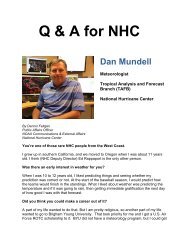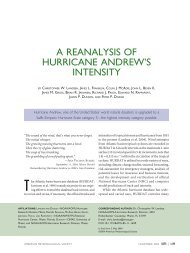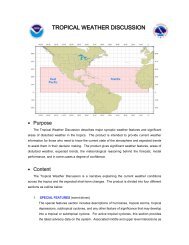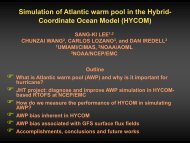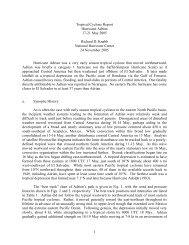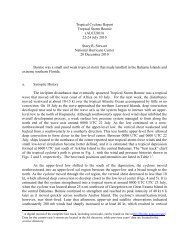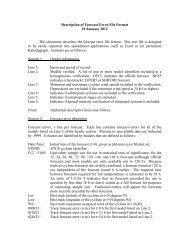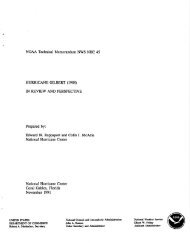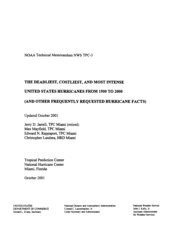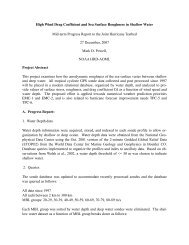High Frequency (HF) Voice Broadcasts â VOBRA Purpose The U.S. ...
High Frequency (HF) Voice Broadcasts â VOBRA Purpose The U.S. ...
High Frequency (HF) Voice Broadcasts â VOBRA Purpose The U.S. ...
Create successful ePaper yourself
Turn your PDF publications into a flip-book with our unique Google optimized e-Paper software.
<strong>High</strong> <strong>Frequency</strong> (<strong>HF</strong>) <strong>Voice</strong> <strong>Broadcasts</strong> – <strong>VOBRA</strong><br />
<strong>Purpose</strong><br />
<strong>The</strong> U.S. Coast Guard provides basic weather information from the National Weather<br />
Service in the form of routine <strong>High</strong> <strong>Frequency</strong> voice broadcasts (also known as<br />
"<strong>VOBRA</strong>") in order to provide service to vessels operating in areas beyond the range of<br />
coastal NOAA Weather Radio stations. This information is prepared cooperatively by<br />
the Ocean Prediction Center, National Hurricane Center and Honolulu Forecast Office.<br />
Content<br />
<strong>The</strong>re are two Offshore Waters Forecast provided by the NHC/TAFB. <strong>The</strong> MIAOFFNT3<br />
(WMO header FZNT23 KNHC) covers the Caribbean Sea, and portions of the Atlantic<br />
Ocean south of 31° North and west of 55° West. <strong>The</strong> MIAOFFNT4 (WMO header<br />
FZNT24 KNHC) encompasses the Gulf of Mexico.<br />
<strong>The</strong> two <strong>VOBRA</strong> forecasts provide mariners with a general overview of large scale<br />
environmental marine conditions out five days, to include winds, seas, and major<br />
weather impacts. Marine warnings such as gale warnings or warnings for tropical<br />
storms or hurricanes will be headlined for each affected zone through the first 36 hours<br />
of the forecast period. In addition, brief, plain-language synopses are included in the<br />
forecast for the Gulf of Mexico, the Caribbean Sea and Tropical Atlantic, and the<br />
Southwest North Atlantic areas.<br />
Winds represent predominant conditions at 10 meters above the surface of the water.<br />
Wind direction is described by the eight points of the compass.<br />
Sea state is described in terms of “significant wave height” which is defined in the NWS<br />
Glossary as “the mean or average height of the highest one third of all waves in a swell<br />
train or in a wave generating region. It approximates the value an experienced observer<br />
would report if visually estimating sea height.” Seas will typically be expressed in terms<br />
of a range (e.g. 2 to 4 ft). This is to represent uncertainty in the forecast, especially<br />
considering the large areas of each marine zone. In fact, it is important to emphasize<br />
that there is a broad spectrum of wave heights at any given time in any part of the<br />
ocean, and individual wave heights may be twice the significant wave height. Unlike the<br />
Offshore Waters Forecasts, the <strong>VOBRA</strong> forecasts do not include swell information. This<br />
is due the limited broadcast times available.<br />
<strong>The</strong> <strong>VOBRA</strong> forecasts also include weather impacts whenever they are expected to<br />
pose a danger to navigation. This may be in the form of widespread areas of fog,<br />
smoke, or volcanic ash that limit visibility, or large clusters of moderate to strong<br />
thunderstorms.<br />
Coverage<br />
TAFB issues two <strong>VOBRA</strong> text forecasts, as shown below with the following<br />
AWIPS/WMO headers:
AWIPS/WMO<br />
Identifiers<br />
FZNT31<br />
KNHC/MIAOFFN20<br />
FZNT32<br />
KNHC/MIAOFFN21<br />
Description of Area<br />
Caribbean Sea and portions of the Western Atlantic Ocean<br />
south of 31° North and west of 55°West<br />
Gulf of Mexico<br />
AWIPS Header MIAOFFN20 – WMO Header FZNT31 KNHC<br />
Area of coverage: Caribbean Sea, Southwest North Atlantic (south of 31°North and<br />
west of 65° West) and the Tropical North Atlantic (from 07°North to 19°North west of<br />
55°West) and includes the following combination of the offshore waters zones in the<br />
Caribbean Sea and Tropical North Atlantic Ocean<br />
●<br />
●<br />
●<br />
●<br />
●<br />
●<br />
●<br />
NW Caribbean W of 85W<br />
Caribbean N of 15N between 72W and 85W<br />
Caribbean from 11N to 15N W of 70W<br />
SW Caribbean S of 11N<br />
Caribbean between 64W and 72W<br />
Offshore Leeward Islands and adjacent Atlantic waters from 15N to 19N W of<br />
55W<br />
Offshore Windward Islands and adjacent Atlantic waters from 07N to 15N W of<br />
55W<br />
and the southwest North Atlantic<br />
●<br />
●<br />
●<br />
●<br />
●<br />
●<br />
Atlantic waters from 27N to 31N W of 77W<br />
Atlantic waters from 27N to 31N between 65W and 77W<br />
Bahamas N of 22N<br />
Atlantic waters from 22N to 27N between 65W and the Bahamas<br />
Atlantic waters S of 22N W of 65W<br />
Atlantic waters from 19N to 22N between 55W and 65W
Combination of offshore zones for the MIAOFFN20 <strong>VOBRA</strong> text product<br />
AWIPS Header MIAOFFN21 – WMO Header FZNT32 KNHC<br />
Area of coverage: Gulf of Mexico and includes the following combination of the offshore<br />
waters zones in the Gulf of Mexico<br />
Portions of Offshore Waters Forecasts parsed into the Broadcast:<br />
● Gulf of Mexico N of 26N W of 87W<br />
● Gulf of Mexico from 22N to 26N W of 87W<br />
● Gulf of Mexico S of 22N W of 87W<br />
● Gulf of Mexico E of 87W
Combination of offshore zones for the MIAOFFN21 <strong>VOBRA</strong> text product
Issuance/Transmission<br />
<strong>The</strong> transmissions originate from six sites located around the country and the<br />
transmission range is dependent upon operating frequency, time of day and<br />
atmospheric conditions and can vary from only short distances to several thousand<br />
miles. Best reception can be achieved by proper selection of frequency and an<br />
adequate antenna system. <strong>HF</strong> <strong>Voice</strong> <strong>Broadcasts</strong> covering TAFB’s marine area of<br />
responsibility are conducted by the USCG from transmitter sites in Chesapeake, VA,<br />
and (New Orleans) Belle Chase, LA. See tables below for station broadcast schedules.<br />
<strong>HF</strong> <strong>Voice</strong> Broadcast Schedule (Times in UTC)<br />
Zone forecast broadcast times indicated by orange shading. <strong>High</strong> Seas forecast<br />
broadcast times are unshaded.<br />
Chesapeake (NMN)<br />
4426, 6501, 8764 kHz (USB) 0330 0515 0930<br />
6501, 8764, 13089 kHz (USB) 1115 1530 2130 2315<br />
8764, 13089, 17314 kHz (USB) 1715<br />
New Orleans (NMG)<br />
4316, 8502, 12788 kHz (USB) 0330 0515 0930 1115 1530 1715 2130 2315




